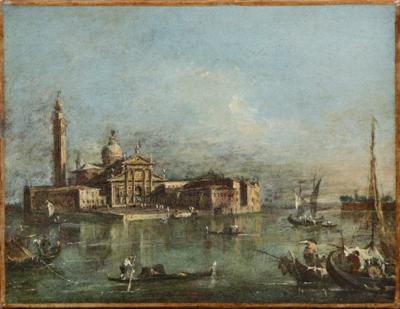Francesco Guardi

(Venice 1712–1793)
San Giorgio Maggiore, Venice,
oil on canvas, 23 x 30 cm, framed
Provenance:
Private collection; sale, Sotheby’s, London, 3 July 1997, lot 88 (as Francesco Guardi);
Private European collection
Literature:
D. Succi, Francesco Guardi. Catalogo dei dipinti e disegni inediti, Milan 2021, p. 96, no. 126 (as Francesco Guardi)
This painting represents the Palladian church of San Giorgio Maggiore and its adjacent monastery. The church’s bell tower collapsed in 1774, and it was not rebuilt until 1791 with a different roof. However, in the present painting, datable to the latter half of the 1780s, Francesco Guardi disregarded this change, most probably for aesthetic reasons, and instead he continued to depict the bell tower in almost all the views he made of this subject, even after the collapse. At the right edge of the canvas, the extreme eastern end of the island of Giudecca can be seen, while the foreground is animated by a multitude of gondolas and other shipping.
Guardi made numerous paintings of the Isola di San Giorgio, which became one of the Venetian painter’s most celebrated and sought-after subjects. The present painting can, for example, be compared to that in the Wallace Collection, London (68.7 x 91.5 cm., inv. no. P491) and another in the Gallerie dell’Accademia, Venice (69 x 94 cm, inv. no. 709) amongst others.
Francesco Guardi was not only one of the great vedutisti, but also one of the most important painters of the eighteenth century. He painted works characterised by a nostalgic, evanescent atmosphere, which seem almost to predict the decline of the Republic of Venice. In its emotive evocation of atmosphere, Guardi’s work is considered by some scholars to be an important precursor of the Romantic movement.
Francesco Guardi trained in the family studio, only taking up view painting toward the end of the 1750s. Until then he had principally worked as a figure painter alongside his brother Gianantonio. Initially he worked from the examples of Canaletto and Michele Marieschi, but soon Guardi developed his own entirely personal idiom, distancing himself from the highly focused and controlled manner of his models. His paintings are characterised by a fluid and vibrant stroke and in his later works, his style became increasingly free, verging on the dissolution of perspectival certainty while dissolving the figures into iridescent cyphers of colour.
Esperto: Mark MacDonnell
 Mark MacDonnell
Mark MacDonnell
+43 1 515 60 403
oldmasters@dorotheum.com
11.05.2022 - 16:00
- Prezzo realizzato: **
-
EUR 76.800,-
- Stima:
-
EUR 60.000,- a EUR 80.000,-
Francesco Guardi
(Venice 1712–1793)
San Giorgio Maggiore, Venice,
oil on canvas, 23 x 30 cm, framed
Provenance:
Private collection; sale, Sotheby’s, London, 3 July 1997, lot 88 (as Francesco Guardi);
Private European collection
Literature:
D. Succi, Francesco Guardi. Catalogo dei dipinti e disegni inediti, Milan 2021, p. 96, no. 126 (as Francesco Guardi)
This painting represents the Palladian church of San Giorgio Maggiore and its adjacent monastery. The church’s bell tower collapsed in 1774, and it was not rebuilt until 1791 with a different roof. However, in the present painting, datable to the latter half of the 1780s, Francesco Guardi disregarded this change, most probably for aesthetic reasons, and instead he continued to depict the bell tower in almost all the views he made of this subject, even after the collapse. At the right edge of the canvas, the extreme eastern end of the island of Giudecca can be seen, while the foreground is animated by a multitude of gondolas and other shipping.
Guardi made numerous paintings of the Isola di San Giorgio, which became one of the Venetian painter’s most celebrated and sought-after subjects. The present painting can, for example, be compared to that in the Wallace Collection, London (68.7 x 91.5 cm., inv. no. P491) and another in the Gallerie dell’Accademia, Venice (69 x 94 cm, inv. no. 709) amongst others.
Francesco Guardi was not only one of the great vedutisti, but also one of the most important painters of the eighteenth century. He painted works characterised by a nostalgic, evanescent atmosphere, which seem almost to predict the decline of the Republic of Venice. In its emotive evocation of atmosphere, Guardi’s work is considered by some scholars to be an important precursor of the Romantic movement.
Francesco Guardi trained in the family studio, only taking up view painting toward the end of the 1750s. Until then he had principally worked as a figure painter alongside his brother Gianantonio. Initially he worked from the examples of Canaletto and Michele Marieschi, but soon Guardi developed his own entirely personal idiom, distancing himself from the highly focused and controlled manner of his models. His paintings are characterised by a fluid and vibrant stroke and in his later works, his style became increasingly free, verging on the dissolution of perspectival certainty while dissolving the figures into iridescent cyphers of colour.
Esperto: Mark MacDonnell
 Mark MacDonnell
Mark MacDonnell
+43 1 515 60 403
oldmasters@dorotheum.com
|
Hotline dell'acquirente
lun-ven: 10.00 - 17.00
old.masters@dorotheum.at +43 1 515 60 403 |
| Asta: | Dipinti antichi I |
| Tipo d'asta: | Asta in sala con Live Bidding |
| Data: | 11.05.2022 - 16:00 |
| Luogo dell'asta: | Wien | Palais Dorotheum |
| Esposizione: | 30.04. - 11.05.2022 |
** Prezzo d'acquisto comprensivo di tassa di vendita e IVA
Non è più possibile effettuare un ordine di acquisto su Internet. L'asta è in preparazione o è già stata eseguita.
